Etretat 作者: 来源: 发布时间:2021-09-27
I.Population and Area
Region: Haute-Normandie
Department: Seine-Maritime
Code Insee : 76254
Code postal : 76790
Total Area: 4.07km²
Population in 2017: 1 291
Population Density: 317 /km²
Details: The altitude of the city hall of Étretat is approximately 20 meters. Its surface area is 4.07 km². The latitude and longitude of Villers are 49.708 degrees North and 0.205 degrees East. Towns and villages close to Étretat are: Le Tilleul (76790) at 2.71 km, Bénouville (76790) at 3.43 km, Bordeaux-Saint-Clair (76790) at 3.85 km, La Poterie-Cap-d'Antifer (76280) at 4.04 km, Pierrefiques (76280) at 4.38 km.
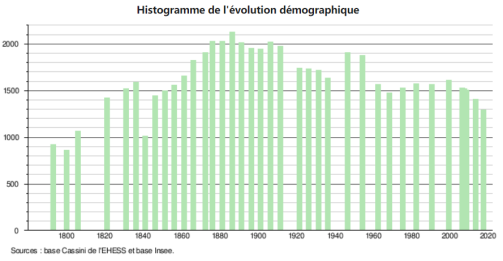
Histogram of demographic change
Sources :http://www.cartesfrance.fr/carte-france-ville/76254_Etretat.html
II.Natural Geography
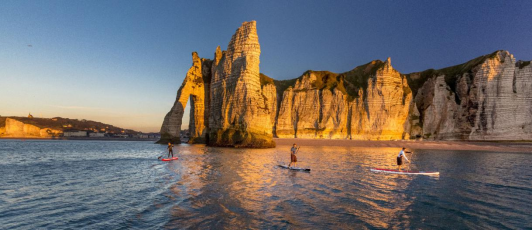
Geographical environment: The little town of Etretat is located in the Pays de Caux, on a section of the coast of Normandy called “La Côte d’Albâtre”, and is renowned for its impressive white cliffs, featuring arches, a large rock needle and tunnels.
Climat: The Étretat lies on 8m above sea level The climate is warm and temperate in Étretat. There is significant rainfall throughout the year in Étretat. Even the driest month still has a lot of rainfall. The climate here is classified as Cfb by the Köppen-Geiger system. The average temperature in Étretat is 10.6 °C (51.1 °F). About 700 mm( 27.6 inch) of precipitation falls annually. The warmest month of the year is July, with an average temperature of 17.3 °C ( 63.1 °F). In January, the average temperature is 4.3 °C (39.7 °F). It is the lowest average temperature of the whole year. The driest month is April, with 47 mm (1.9 inch) of rainfall. Most precipitation falls in November, with an average of 80 mm (3.1 inch).
Transport: Étretat is not reached by a motorway, but its closeness to Normandy’s largest cities such as Le Havre (19km) and Rouen (90km) makes it easily accessible by car from Paris (219km), Calais and Caen. From Paris, take the A13 and A131 motorways in the direction of Le Havre. From there, follow the single carriage-way route départementale 79 which runs through the Côte d’Albatre. If you are travelling from Australia, either take a flight to Paris Charles de Gaulle airport and rent a car from there, or fly to London. Ferries cross the Channel regularly from Portsmouth to Le Havre.
(1) By Train and Bus to Etretat:Trains no longer operate all the way to Etretat. Travelers using public transportation usually have to transfer to a bus service at Le Havre but occasionally Bréauté or Fecamp can also be sensible options. From Paris, the direct Flixbus is the best options but this service is seasonal and does not operate daily. Trains arrive frequently in Le Havre from Paris and Rouen. However, the lack of bridges across the Seine means that travelers from most other parts of France will have to change trains at either Rouen or even Paris-Saint Lazare en route to Le Havre. French train tickets may be bought from the official websites of French Railways such as Oui.SNCF and RailEurope but Trainlines are often far easier to use.
(3) Airports: Closest airport to Étretat is Le Havre – Octeville Airport (LEH). Distance from Le Havre – Octeville Airport to Étretat is 13.1 miles / 21.0 kilometers. Le Havre – Octeville Airport is located approximately 2.9 miles / 4.7 kilometers north of Le Havre and about 4.5 miles / 7.3 kilometers west of Montivilliers. IATA airport code is LEH. The main bus service to Etretat is line 24 between Le Havre via Etretat and Fecamp. Ligne n° 24 is operated by Keolis Seine Maritime – currently, this bus service is not included in transportation searches at Oui.SNCF but the timetable is available on the Etretat Tourist Office website.
Sources : https://en.climate-data.org/europe/france/upper-normandy/etretat-727245/
https://www.european-traveler.com/france/normandy/transportation-etretat-normandy/
III.Economy
Etretat Accounting income in 2018 was 607 100 €, or 468 € per inhabitants.
Self-financing capacity in 2018 was 629 700 €, or 485 € per inhabitants.
Income: According to Insee, in 2015, the inhabitants of Etretat earn on average € 2 000 net per month, or €24 000 net per year.
Unemployment rate: In 2016, its unemployment rate was 14%, which was much higher than the French average of 11%.
Companies: In 2017, the total number of companies in Etretat was 153, and there were 10 new companies.
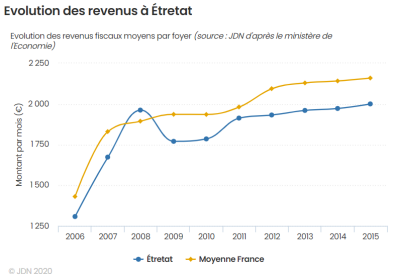
Evolution of average monthly net wages
Sources : http://www.journaldunet.com/management/ville/etretat/ville-76254/budget
http://www.journaldunet.com/business/salaire/etretat/ville-76254
http://www.journaldunet.com/management/ville/etretat/ville-76254/emploi
http://www.journaldunet.com/management/ville/etretat/ville-76254/entreprises
IV.Industrial Characterisitics
The economy of Étretat rests mainly on tourism, which gives the locals a growing commercial outlet. The city places itself as the number one tourist attraction in former Normandy, as the site most visited along with Bénédictine distillery and museum at Fécamp, the Rouen Cathedral and the Claude Monet Foundation in Giverny.
During the eighteenth and nineteenth centuries the economy was supplemented by kelp-burning on the beaches. The white plumes of smoke by the shore can be clearly seen in George Inness' painting 'Étretat' (1875, Wadsworth Athenaeum). "The discovery and development of iodine-rich mineral deposits in Chile about the same time the iodine-from-kelp industry reached full vigor, dealt the kelp industry another severe blow in the late 1870s. However, small quantities of kelp continued to be harvested for soda, potash and iodine in northern France".
Source: http://www.alsace-wine.net/b/eguisheim.shtml
V.Attractions
1.The pebble beach
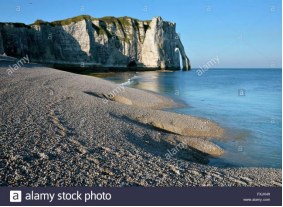
Once standing on the beach, the cliff formations are visible on each side: the Falaise d’Aval to the left and the Falaise d’Amont to the right. As it is surrounded by cliffs, the little beach is relatively protected from the winds. Many tourists come here in summer to admire the magnificent setting of Étretat, contributing to its festive atmosphere. Taking the shingle from the beach is forbidden as it serves as a protection from erosion by the sea. The beach is separated from the village by a long promenade, named “le perrey” after a local dialect word meaning “in stoned” (empierré). A “perrey” used to be the place where boats were running aground. Today, the sea-wall serves as a protection for the town from violent storms, particularly during the large tides of equinoxes. The little town’s origins as a fishing village are still evident with capstans and fishermen’s huts on the sea front, next to the beach. To enjoy a visit to the small but popular beach and the surrounding cliffs, it is essential to know the high and low tide timetables, in order to avoid being trapped between two cliffs by the rising tide.
Source: https://frenchmoments.eu/etretat/
2.The Cliffs
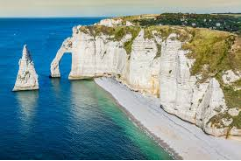
The withe cliffs of Etretat are one of the most popular sights in Normandy and famous for Monet’s paintings. The impressive three rock arches “falaises” created by incredible forces of nature over thousands of years ago are a must to visit. It’s breath-taking to watch the waves crashing against the arches. They are accessible during low tide. The two arches Porte d’Aval and Falaise d’Amont can be already seen from the promenade in Etratat.
The outstanding 70 metre-high white cliffs of Étretat are world famous and are classified as a national site, with its three rock formations, known as: – Porte d’Amont (the upstream cliff) – a large rock that juts into the sea, – Porte d’Aval (the downstream cliff) – arguably the most impressive cliff with its arch and needle, and – Manneporte – featuring a second natural rock arch above the sea.
(1)The Falaise d’Aval: The Falaise d’Aval is reached by a set of stairs (180 steps) leading up to the crumbling (and windy!) side of the cliff. The path starts at the right end of the beach, where you can see remains of bunkers, part of the “Atlantic Wall”, an extensive system built by the Germans to defend against an anticipated Allied invasion of continental Europe from Great Britain. The local flora has adapted to the cold and violent winds hitting the coast, which have the effect of drying out the soil. This explains why the plants are smaller in size, as well as the absence of trees. From the top, the view reaches as far as Le Havre. But the eye is drawn to the abrupt cliff and the notorious arch, looking as an elephant dipping his trunk into the sea. Standing next to it is the “Hollow Needle” (L’Aiguille Creuse), made famous by Maurice Leblanc. The French novelist, a contemporary of Conan Doyle, created the character of Arsène Lupin, the Gentleman Thief and set his legendary refuge inside the Needle. Leblanc is not the only artist who found inspiration in Étretat: Monet, Boudin, Maupassant and Flaubert were also impressed by the grandeur of this part of Normandy. Several paintings from Monet were painted in and around Etretat. The view from the top is outstanding for it embraces the bay of Étretat and the Falaise d’Aval with the Hollow Needle.
(2)The Falaise d’Amont: As for reaching the top of the Falaise d’Aval, a very steep stair-path winds up to the top of the “Falaise d’Amont”. (You will need approximately 1 hour for a return walk). Here stands the Notre-Dame de la Garde Chapel, made of stone. In 1854, Étretat’s fishermen decided to build a chapel dedicated to the Holy Virgin, their Patron Saint. The Nazis blew out the building in 1942 and it was rebuilt in the early 1950’s. Behind the Chapel stands another monument, which looks like a tall white arrow, dedicated to aviators Nungesser and Coli, who were the first to attempt the crossing of the Atlantic Ocean without stopping. They departed on the 8th May 1927 but were never seen since. Along your walk on Étretat’s cliffs, many birds can easily be observed at a close distance: Common Gulls of course, but also Herring Gulls, Arctic Fulmars, Peregrine Falcons and Cormorants.
Source: https://frenchmoments.eu/etretat/
3.Etretat Gardens
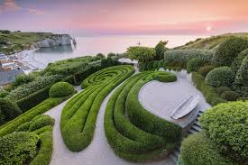
The Étretat Gardens (French: Les Jardins D'Étretat) is a cliff-top experimental garden with "living sculptures" in Étretat, Normandy, France. It surrounds a villa that once belonged to Madame Thébault, an actress from Paris, in the beginning of the 20th century. More than a century later, the garden was restored by a team led by the Russian landscape architect Alexander Grivko of the British garden design and landscaping company IL Nature, who was inspired by the flora of the Normandy coast. It was reopened to the public in 2017.
Grivko was awarded the 2019/2020 European Garden Award in "Best restoration or development of a historic park or garden" category for his work. The Étretat Gardens are listed among "Great Gardens of the World" and also received a star from the Michelin Green Guide.
There are seven parts of the gardens:
(1)Jardin Avatar is situated at the entrance to Les Jardins d'Étretat. Avatar was the Sanskrit title of the guardian of the Universe, who permeated it with his divine presence. Jardin Avatar is a gateway that leads visitors beyond the bounds of reality, into the magical realm of surrealism. There even trees make their music. Strikingly trimmed plants beckon the visitor to step into a fairytale where anyone can find a path to their own Avatar.
(2)The Jardin Émotions was modelled after the first French oyster farm, which was owned by Queen Marie Antoinette, and lies at the foot of Les Jardin d'Étretat in the waters of the English Channel. The vision of the ocean floor became the main inspiration for this garden. The trimmed plants echo the landscapes of the underwater world and the oysters’ habitat. It is also home to a set of expressively sculpted faces. The sculptures capture the entire range of emotions and symbolise the various “moods“ of the ocean and its inhabitants.
(3)Jardin Impressions is the heart of Les Jardins d’Étretat. The garden opens up on the iconic historical panorama of the ocean and the cliffs of Étretat, which have inspired many great artists. Jean-Baptiste Camille Corot, Eugène Delacroix, Edouard Manet, Claude Monet, and Vasily Polenov – all came here to paint. The topiary compositions embody the tides and ebbs of the English Channel, enhancing the effect of being immersed under water.
(4)Jardin d’Aval is a meeting and resting point for the garden’s visitors. The tale of Alice in Wonderland inspired it. The garden is magically surrounded by fanciful plants and numerous yew arches symbolising the famous Aval cliff of Étretat. Jardin d’Aval boasts a rich collection of orchids, their blooming flowers enhancing the garden's air of surrealism with their unusual colours and shapes.
(5)Jardin Zen embodies a harmonious coexistence of man and nature. Only plants with white blossoms grow here, instilling into the viewer a sense of virginal purity and the unity with nature. The garden features an audio installation, the purpose of which is to awaken the forces of good and to allow visitors to discover new ways of seeing their surroundings through art.
(6)Jardin La Manche is situated at the centre of Les Jardins d'Étretat. It is composed of mazes made of large-scale trimmed plants, evocative of the troubled waves of the ocean. The silvery colour of the leaves in the plant compositions resembles the sea foam on the crests of the waves crashing against the cliffs of Étretat in a storm. Jardin La Manche is renowned for its ability to inspire vivid emotions in visitors. When falling into the vortex of the raging element, one wishes to escape from it and to “stay alive”.
(7)Jardin d'Amont towers majestically over Les Jardins d'Étretat. The plants morph into cliffs and merge with the line of the horizon. They imitate the rocky layers of the White Cliffs of Normandy’s Alabaster Coast and astonish with their mathematical precision and geometric synchronicity. The terrace of Jardin d’Amont is the highest vantage point of Les Jardins d'Étretat, overlooking the gardens and the enchanting scenery of Étretat.
lAddress: Avenue Damilaville, 76790 Étretat, France
lWebsite:https://etretatgarden.fr/en/
Source: https://etretatgarden.fr/en/
4.Chapelle Notre dame de la Garde
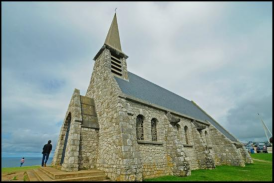
Chapelle Notre dame de la Garde was built on the upstream cliff in 1854 by the mission of Reverend Père Michel and by the inhabitants of France, in homage to the missing sailors carried away by the whims of the sea, it has inspired great painters and writers such as Claude Monet, Gustave Flaubert and Guy de Maupassant. It was destroyed under occupation, in 1942. And it was completely rebuilt after the Second World War, in 1950.
Source: https://www.lehavre.catholique.fr/chapelle-notre-dame-de-la-garde/
VI.History
An old legend says that the village was founded following a Viking invasion. Étretat’s fame was settled in the 19th century when, from a fishing village, it quickly became a fashionable seaside resort. Little by little, the traditional activity of fishing was substituted by tourism. Paris and the largest cities in Normandy were not far and the construction of a railway line made transportation easier towards this little town. The train line has since been taken out of service, only to be transformed into a touristic train: le train touristique Étretat Pays de Caux. You can reach Les Loges downhill by handcar (6km) and come back by an old-fashioned train. However, one doesn’t come to Étretat just for bathing. Unlike other places nearby, Étretat does not have sand but pebble beaches. Here, the real features are the surrounding cliffs, one of the most visited sites in Normandy.
Estrustat, the original name of Etretat, is mentioned in the 12th century and could come from ostreosa statio which means oyster station, to est which means narrow and could evoke the configuration of Etretat, tight between two cliffs or still estruere, Latin verb meaning to hole, to pierce. The inhabitants are called the Etretatais.
Sources: https://frenchmoments.eu/etretat/
https://www.lehavre.catholique.fr/chapelle-notre-dame-de-la-garde/
VII.Other information
The city has risen to the very first rank of the most visited Upper Normandy tourist sites with the Benedictine Palace in Fécamp, Rouen Cathedral and the Claude Monet Foundation in Giverny with day tours. The site and the city welcome between 1 and 2 million visitors per year depending on the statistics. The site is classified under the law of 1930 and includes several Natura 2000 zones and Sensitive natural areas, properties of the Conservatoire du Littoral for the protection of its biodiversity. The cliffs receive an average of 3,000 visitors per day in summer, which creates problems of sustainable development and environmental protection.
The Etretat Garden is the winner of the European Garden Award in the category "Best development of a historic park or garden", possesses one MICHELIN star in the Green Guide, listed among "Great Gardens of the World" and has the label "Remarkable Garden".
Sources : https://frenchmoments.eu/etretat/
VIII.Contact information
Address of Etretat town hall:
Mairie de Étretat
1, place Maurice-Guillard
76790 Étretat
Phone number: 02 35 27 01 23
Fax: 02 35 28 59 37
Email: mairie-sg.etretat@wanadoo.fr
Website: http://www.etretat.fr
Mayor : Franck Cottard (Mandate : 2014-2020)
Sources : http://www.cartesfrance.fr/carte-france-ville/76254_Etretat.html#mairie
